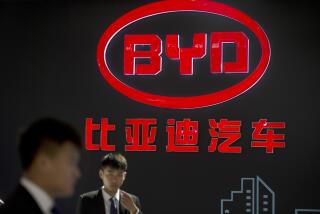Mexican Auto Industry Braces for Competition
AGUASCALIENTES, Mexico — Mexican car production is back in full swing, consumers are snapping up new models as never before and Toyota Motor Co. is about to break ground on its first Mexican auto factory, a $100-million show of confidence.
So why is the Mexican car industry nervous?
Declining worker productivity, the strong peso and the failure of President Vicente Fox to push through tax, energy and labor reforms certainly are causes for worry. So is a law set to take effect in 2004 that will end an import quota system that has protected the Mexican retail market.
But the biggest worry is globalization. The world market is changing at warp speed, forcing car makers to cut manufacturing costs to the bone to give consumers more for their money.
Can Mexico maintain its status as an export hub amid competition from other developing countries?
“It will be very challenging. Everyone is using the best available marketing and technology to try to stay ahead of the changes that globalization is causing,” said Hiroshi Yoshioka, president of Nissan Motor Co.’s Nissan Mexicana unit, operator of a sprawling auto plant in this arid city in south-central Mexico.
No one is saying that Mexico will cease being an important auto manufacturing center. Although showing no growth last year, total Mexican car production still topped 1.8 million vehicles in 2001, up 50% since 1996.
Meanwhile, the number of vehicles rolling off U.S. and Canadian assembly lines remained flat over the same five-year period.
The most recent industry figures indicate that Mexican auto plants are regaining the ground they lost last year to the recession in the United States, where three-fourths of all cars and trucks built in Mexico are sold: April output jumped 12.5% from March.
But because of intensifying competition from other low-cost manufacturing centers, from Brazil to Thailand, export-directed production in Mexico could slow from the explosive growth rate of the last five years.
*
New Models Ignite Domestic Market
The biggest driver of the Mexican auto industry over the next decade may be the domestic market, which seems poised for a period of dynamic growth, although it represents a much smaller base than exports to the United States and Canada.
Mexico’s domestic car sales through April were up 11.2% from the same four months last year and are on a track to top 1 million units for the year. Igniting the market are new offerings of affordable compact and subcompact cars--such as Nissan’s Platina introduced last month--that sell for less than $10,000.
At the same time, Mexico is lowering its import barriers to let in more cars made in Europe and elsewhere in Latin America, including Peugeots from Chile, GM Corsas and other Nissan models from Europe and Volkswagens from Brazil.
Mexico is expected to sign trade deals with European Union and Mercosur trading bloc countries that will lower import duties and make it tougher for local factories to compete on a cost basis for the right to supply Mexican showrooms with inventory.
Mexican manufacturers also worry about the flood of used U.S. cars that enter the country illegally, robbing Mexican dealers of sales. That flood may become a torrent after import rules are liberalized in 2004
Over the last decade, Mexico has been a prime beneficiary of free hemispheric trade and the U.S. auto industry’s obsessive drive to cut costs. Billions of dollars have been poured into new auto parts and vehicle assembly operations by General Motors Corp., Ford Motor Co. and DaimlerChrysler.
With Toyota breaking ground in mid-June on a Baja California factory to make light truck components, all major Japanese auto manufacturers have or soon will have a manufacturing presence in Mexico.
But despite the excitement caused by Toyota’s announcement, there is uneasiness about whether the Mexican automotive industry can continue to expand and provide the job growth the nation has come to count on. The automotive industry is by far the largest private employer, with 770,000 workers, or about 6% of all formal employees in Mexico.
*
Mexico Losing Some of Its Attraction
There are signs that auto parts manufacturers, which accounted for 11% of foreign direct investment in Mexico in the late 1990s, are less enchanted with Mexico these days, according to a survey by auto consultant A.T. Kearney in Mexico City that found new parts investment and sales leveling off.
Several top auto executives warned Fox in March that Mexico was losing some of its attraction.
“The problem is that Mexican productivity has slowed in relation to other countries and Mexican labor costs are higher than in other developing countries,” said Kearney’s Carlos Niezen.
Latin American market analyst Kim Kennedy of J.D. Power & Associates in Troy, Mich., said the manufacturing landscape is rapidly changing. Countries such as Brazil, whose currency has been devalued by 60% since 1999, are more attractive to global auto makers.
Nissan, which started assembling cars in Aguascalientes in 1992, has instituted sweeping changes in its sprawling factory since its 1999 alliance with Renault. Many of those changes were sparked by alliance Chief Executive Carlos Ghosn’s mandate that Nissan’s factories worldwide achieve 20% cost reductions over a three-year period.
The Nissan factory and its 3,100 workers offer a glimpse of what globalization is doing to the car industry.
Workers fit engines made at Renault’s Brazil factory onto the “platform”--chassis and drive train--used to make both the Renault Clio and the Nissan Platina subcompacts. Parts now come from the lowest global bidder and not from wholly or partly owned Nissan affiliates, another Ghosn mandate. The Nissan models have Renault styling touches, and Renaults have Nissan engineering.
The alliance of the auto industry’s odd couple appears to be working, and this factory played an important role, doubling its unit output since 1999, when production of all Nissan Sentras for the U.S. market was moved here.
The alliance’s factories here and in Cuernavaca have played crucial roles in Nissan’s dramatic recovery from near bankruptcy in 1999. Profit for the fiscal year ended March 31 was a record $2.96 billion on sales of $47.7 billion, and the company hit its 20% cost-reduction goal a year early.
Nissan’s unit sales in the U.S. through May 12 were up 23% from the same period last year, according to A.T. Kearney’s John Hoffecker in Southfield, Mich.
Shortly after Yoshioka was named Nissan’s Mexico director, he named Armando Avila Moreno, 44, the factory’s first Mexican manager, a dramatic break with the Nissan tradition of putting Japanese managers in charge of plants.
“The rules have changed for the entire industry, all over the world,” said Avila, a 19-year Nissan employee. “Profit margins are lower. The point is to increase volume and reduce the cost of inventory, to synchronize production as closely as possible to delivery to customers.”
The cost-reduction mantra is being uttered by all car makers these days. Globalization means increasing competition at the retail level, as well as in manufacturing.
With countries such as Mexico generally lowering trade barriers and tariffs, consumers are seeing more brands competing on price. The competition has been fueled in Mexico by low-cost car financing offered by several manufacturers and by declining prices, especially for low-end compacts and subcompacts, which in Mexico account for 92% of new-car sales.
Lower production costs mean manufacturers can offer more safety features and more powerful engines for the same money, said Nissan’s Yoshioka. Cost savings also are imperative so the companies can research new technologies, such as fuel cells.
“It’s not that other car companies are following our example, they are doing it from the necessity of the global car market,” Yoshioka said.






